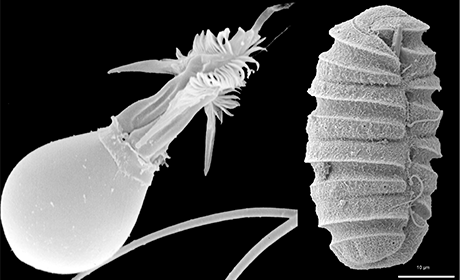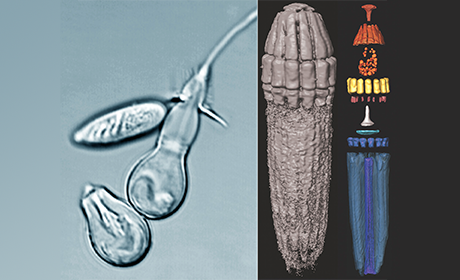Similar Design, Different Genes: Miniature Weapons in the Animal Kingdom
9 June 2017

Figure left: Thomas Holstein und Pierre Tardent, right Urban Tillmann und Greg Gavelis
Figure right: Dinoflagellate Polykrikos kofoidii containing the spear-like nematocyst.
In evolutionary convergence, two genetically unrelated organisms evolve similar traits, and biologists at Heidelberg University have now uncovered an example of convergence at the subcellular level in unicellular organisms and cnidarians. Together with colleagues from Canada, Associate Professor Dr Suat Özbek and Prof. Dr Thomas Holstein have discovered that the two organisms developed similar miniature weapons for prey capture over the course of their evolution, although they share no common genetic basis. The Heidelberg researchers study the function and molecular structure of these "weapons systems" at the Centre for Organismal Studies.
With their powerful stings, jellyfish, sea anemones, and corals are a well-known hazard among ocean swimmers. The eponymous cell type of the 500-million-year-old Cnidaria is the cnidocyte, which contains microscopically small organelles – the stinging capsules also known as cnidocysts or nematocysts. When the cell is triggered, the capsule forcefully ejects the spear-tipped tubule coiled inside. Like a miniature harpoon, these subcellular weapons systems penetrate their prey while simultaneously injecting paralysing poisons.
How these organelles arose during evolution is hitherto unknown. According to Prof. Holstein, the leading hypothesis assumes that they originated from organelles of similar construction and function in unicellular organisms that were absorbed as symbionts by early precursors of cnidarians. In fact, structurally comparable weapons systems, called nematocysts as well, are found in a group of modern protozoans, the dinoflagellates. The current doctrine claims that the two share a common genetic origin.
The research group led by Suat Özbek und Thomas Holstein compared the molecular components of both organelles and made a surprising discovery: The two don't match up at all. In their analysis, the Heidelberg group, together with a group from the University of British Columbia in Canada, showed that the cnidaria and dinoflagellates use entirely different genes and proteins to construct their respective miniature harpoons. The comparative study is based on a comprehensive proteome analysis of isolated Cnidarian nematocysts by the Heidelberg researchers.
The two biological systems are fundamentally different genetically, according to Prof. Holstein. Yet high-resolution 3D images of the nematocysts show a previously unknown complexity and similarity in the biomechanics of discharge. The dinoflagellate Polykrikos lebouriae, for example, ejects a pointed projectile. Another dinoflagellate, the Nematodinium, fires up to 15 projectiles one after the other, similar to a multi-barelled gun. Whereas the acceleration of cnidarian nematocysts is driven by high internal pressure, the dinoflagellates lack the necessary metabolic pathways. "The underlying mechanisms still need to be clarified," states the Heidelberg researcher, who leads the Molecular Evolution and Genomics research group at the Centre for Organismal Studies.
"Our investigation leads us to conclude that exceptional and extreme cases of convergence exist at the subcellular level," stresses Prof. Holstein. In evolutionary biology, convergence describes the development of similar constructional principles without the organisms having a common phylogenetic origin. One prominent example of convergence is the formation of wings in birds and bats. Such matches in different organism groups are created by adapting to similar environmental requirements.
Starting from simple secretory vesicles, which released enzymes and adhesive proteins to attach to and digest other cells, highly complex subcellular weapons systems in cnidarians and dinoflagellate genes presumably developed in different ways. This process could have been fostered by improving protection mechanisms in prey organisms leading to similar evolutionary solutions in predators. Thomas Holstein states that the protozoans are characterised by a wide variety of different ballistic organelles, suggesting an "arms race" at this early stage of evolution.
Their recent research results were published in the journal “Science Advances”.

Figure left: Suat Özbek, right: Urban Tillmann und Greg Gavelis
Figure right: Nematocysts in the dinoflagellate Nematodinium. Three-dimensional longitudinal reconstruction of the nematocyst from electron-microscope images and a virtual representation of the individual components of the "multi-barelled gun" mechanism with up to 15 projectiles.

